| Revision as of 10:55, 4 May 2007 edit195.239.46.218 (talk) →Post Revolution (1917-1932)← Previous edit | Revision as of 17:03, 10 May 2007 edit undo172.188.101.230 (talk) →Late Muscovite period (1612–1712)Next edit → | ||
| Line 38: | Line 38: | ||
| ]'s residence, the New Jerusalem Cloister, is representative of his conservative aesthetic views.]] | ]'s residence, the New Jerusalem Cloister, is representative of his conservative aesthetic views.]] | ||
| After the ] the state and the church were |
After the ] the state and the church were bankrupted, and could not finance any construction workes. The initiative was taken by rich merchants of the city ]-on-the-]. In the course of the seventeenth centurey, they built numerous large churches of cathedral type, with five onion-like ], and surrounded them with tents of ] and ]. At first the churches' composition was sharply asymmetrical, with different parts balancing each other on the "scale-beam" principle (e.g., the Church of Elijah the Prophet, 1647-50). Subsequently the Yaroslavl churches were strictly symmetrical, with cupolas taller than the building itself, and amply decorated with ] tiles (e.g., the Church of John the Chrysostom on the Volga, 1649-54). A zenith of Volga architecture was attained in the Church of St John the Baptist (built 1671-87), the largest in Yaroslavl, with fifteen cupolas and more than five hundred magnificent frescoes. All the brick exterior of the church, from the cupolas down to the tall porches, was elaborately carved and decorated with tiles. | ||
| The seventeenth-century Moscow churches are also profusely decorated, but their size is much smaller. Earlier in the century, the Muscovites still favoured the tent-like constructions. The chief object of their admiration was the "Miraculous" Assumption Church in ] (1627): it had three graceful tents placed in a row, reminiscent of three burning candles. This composition was extravagantly employed in the Hodegetria Church of ] (1638) and the ], Moscow (1652). Assuming that such constructions ran counter with the traditional Byzantine type, the Patriarch Nikon declared them uncanonical. He encouraged building of fairy-like ecclesiastical residences, such as the ] Kremlin on the ], with five tall churches, innumerable towers, palaces, and chambers. Nikon personally designed his new residence at the ] which was dominated by a rotunda-like cathedral, the first of its type in Russia. | The seventeenth-century Moscow churches are also profusely decorated, but their size is much smaller. Earlier in the century, the Muscovites still favoured the tent-like constructions. The chief object of their admiration was the "Miraculous" Assumption Church in ] (1627): it had three graceful tents placed in a row, reminiscent of three burning candles. This composition was extravagantly employed in the Hodegetria Church of ] (1638) and the ], Moscow (1652). Assuming that such constructions ran counter with the traditional Byzantine type, the Patriarch Nikon declared them uncanonical. He encouraged building of fairy-like ecclesiastical residences, such as the ] Kremlin on the ], with five tall churches, innumerable towers, palaces, and chambers. Nikon personally designed his new residence at the ] which was dominated by a rotunda-like cathedral, the first of its type in Russia. | ||
Revision as of 17:03, 10 May 2007
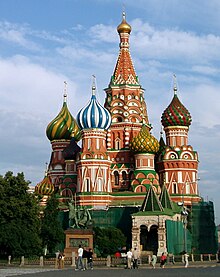
Russian architecture follows a tradition whose roots were established in the Eastern Slavic state of Kievan Rus'. After the fall of Kiev, Russian architectural history continued in the principalities of Vladimir-Suzdal, and Novgorod, and the succeeding states of Muscovy, the Russian Empire, the Soviet Union, and the modern Russian Federation.
Medieval Rus' (988–1230)
Main article: Architecture of Kievan Rus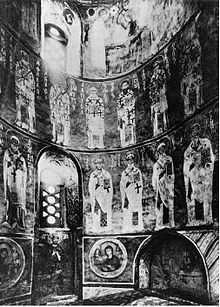
The medieval state of Kievan Rus' was the predecessor of modern states of Russia, Belarus, and Ukraine and their respective cultures, including architecture.
The great churches of Kievan Rus', built after the adoption of Christianity in 988, were the first examples of monumental architecture in the East Slavic lands. The architectural style of the Kievan state which quickly established itself was strongly influenced by the Byzantine. Early Eastern Orthodox churches were mainly made of wood with the simplest form of church becoming known as a cell church. Major cathedrals often featured scores of small domes, which led some art historians to take this as an indication of what the pagan Slavic temples should have looked like. The tenth-century Church of the Tithes was the first prominent building to be made of stone, located in Kiev.
Saint Sophia Cathedral in Novgorod (1044-52), on the other hand, expressed a new style that exerted a strong influence on Russian church architecture. Its austere thick walls, small narrow windows, and helmeted cupolas have much in common with the Romanesque architecture of Western Europe. Even further departure from Byzantine models is evident in succeeding cathedrals of Novgorod: St Nicholas's (1113), St Anthony's (1117-19), and St George's (1119).
Secular architecture of Kievan Rus' has scarcely survived. Up to the twentieth century, only the Golden Gates of Vladimir, despite much eighteenth-century restoration, could be regarded as an authentic monument of the pre-Mongolian period. In the 1940s, the archaeologist Nikolai Voronin discovered the well-preserved remains of Andrei Bogolyubsky's palace in Bogolyubovo, dating from 1158-65.
Early Muscovite period (1230–1530)
The Mongols looted the country so thoroughly that even capitals (such as Moscow or Tver) couldn't afford new stone churches for more than half a century. Novgorod and Pskov however managed to escape the Mongol yoke, and evolved into successful commercial republics. Many dozens of medieval churches, from the twelfth century on, have been preserved in these towns.
The churches of Novgorod, such as the Saviour-on-the-Ilyina-Street (1374), are steep-roofed and carved in a rough manner. Some of them contain magnificent medieval frescoes. The tiny and picturesque churches of Pskov feature many novel elements - corbel arches, church porches, exterior galleries, and bell towers. All these features were introduced by Pskov masons to Muscovy where they built numerous edifices during the fifteenth century, including the Deposition Church of the Moscow Kremlin (1462) and the Holy Spirit Church of the Holy Trinity Lavra (1476).
The fourteenth-century churches of Muscovy are sparse, and their dating is disputed. Typical monuments—found in Nikolskoe village near Ruza (1320s?) and Kolomna (1310s?)—are diminutive single-domed fortified churches built of roughly-hewn ("wild") stone and capable of withstanding brief sieges. By the time of the construction of the Assumption Cathedral in Zvenigorod (1399?), the Muscovite masons managed to regain the mastership of the pre-Mongolian builders and solved some of the construction problems that had puzzled their ancestors. Signature monuments of early Muscovite architecture are to be found in the Holy Trinity Lavra (1423), Savvin Monastery of Zvenigorod (1405?), and St. Andronik Monastery in Moscow (1427).
By the end of the fifteenth century Muscovy was so powerful a state that its prestige badly needed magnificent multi-domed buildings, on the par with pre-Mongolian cathedrals of Novgorod and Vladimir. As Russian masters were unable to build anything like it, Ivan III invited Italian masters from Florence and Venice. They reproduced ancient Vladimir structures in three large cathedrals of the Moscow Kremlin, and decorated them with Italian Renaissance motives. These ambitious Kremlin cathedrals—the Dormition Cathedral, the Archangel Cathedral, and the Annunciation Cathedral—were imitated throughout Russia during the sixteenth century, with new edifices tending to be larger and more ornate than their predecessors (for example, the Hodegetria Cathedral of Novodevichy Convent, 1520s).
Apart from churches, many other structures date from Ivan III's reign. These include fortifications (Kitai-gorod, Kremlin towers, Ivangorod), towers (Ivan the Great Bell Tower), and palaces (the Palace of Facets, the Uglich Palace). The number and variety of extant constructions may be attributed to the fact that Italian architects persuaded Muscovites to abandon prestigious, expensive and unwieldy limestone for much cheaper and lighter brick as the principal construction material.
Middle Muscovite period (1530–1630)

In the sixteenth century, the key development was the introduction of tented roof into brick architecture. Tent-like roof construction is thought to have originated in the Russian North, as it prevented snow from piling up on wooden buildings during long winters. In wooden churches (even modern ones) this type of roof has been very popular.
The first ever tent-like church built in brick is the Ascension church of Kolomenskoe (1531), designed to commemorate the birth of Ivan the Terrible. Its design was prone to most unusual interpretations. Some scholars argue that tent-like roofs have something common with European gothic styles of architecture, and even tend to call this style Russian Gothic. It is likely this type of design, never found in other Orthodox countries, symbolised high ambitions of the nascent Russian state and liberation of Russian art from Byzantine canons after Constantinople's fall to the Turks.
Tented churches were exceedingly popular during the reign of Ivan the Terrible. Two prime examples dating from his reign employ several tents of exotic shapes and colours arranged in a complicated design. These are the Church of St John the Baptist in Kolomenskoye (1547) and Saint Basil's Cathedral on Red Square (1561). The latter church unites nine hipped roofs in a striking circular composition. About that time, the onion domes of various shapes started to replace traditional helmet domes even on the ancient churches.
Late Muscovite period (1612–1712)
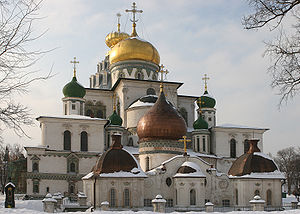
After the Time of Troubles the state and the church were bankrupted, and could not finance any construction workes. The initiative was taken by rich merchants of the city Yaroslavl-on-the-Volga. In the course of the seventeenth centurey, they built numerous large churches of cathedral type, with five onion-like cupolas, and surrounded them with tents of bell towers and aisles. At first the churches' composition was sharply asymmetrical, with different parts balancing each other on the "scale-beam" principle (e.g., the Church of Elijah the Prophet, 1647-50). Subsequently the Yaroslavl churches were strictly symmetrical, with cupolas taller than the building itself, and amply decorated with polychrome tiles (e.g., the Church of John the Chrysostom on the Volga, 1649-54). A zenith of Volga architecture was attained in the Church of St John the Baptist (built 1671-87), the largest in Yaroslavl, with fifteen cupolas and more than five hundred magnificent frescoes. All the brick exterior of the church, from the cupolas down to the tall porches, was elaborately carved and decorated with tiles.
The seventeenth-century Moscow churches are also profusely decorated, but their size is much smaller. Earlier in the century, the Muscovites still favoured the tent-like constructions. The chief object of their admiration was the "Miraculous" Assumption Church in Uglich (1627): it had three graceful tents placed in a row, reminiscent of three burning candles. This composition was extravagantly employed in the Hodegetria Church of Vyazma (1638) and the Nativity Church at Putinki, Moscow (1652). Assuming that such constructions ran counter with the traditional Byzantine type, the Patriarch Nikon declared them uncanonical. He encouraged building of fairy-like ecclesiastical residences, such as the Rostov Kremlin on the Nero Lake, with five tall churches, innumerable towers, palaces, and chambers. Nikon personally designed his new residence at the New Jerusalem Monastery which was dominated by a rotunda-like cathedral, the first of its type in Russia.
Since the tents were banned, the Muscovite architects had to replace them with successive rows of corbel arches ("kokoshniki"), and this decorative element was to become a hallmark of the seventeenth-century Moscow "flamboyant" style. An early example of the flamboyant style is the Kazan Cathedral on Red Square (1633-36). By the end of the century, more than a hundred churches in the fiery style were erected in Moscow, and perhaps as many again in the neighbouring region. Among the more splendid specimens are the Moscow churches of the Holy Trinity at Nikitniki (1653), St Nicholas at Khamovniki (1682), and the Holy Trinity at Ostankino (1692). Probably the most representative flamboyant style structure was the Church of St Nicholas "the Grand Cross" in the Kitai-gorod, brutally destroyed at the behest of Stalin.
As Russian architecture degenerated into pure decoration, it was also influenced by the Polish and Ukrainian Baroque. The first baroque churches were small chapels built on the Naryshkin family estates near Moscow, hence the name of Naryshkin baroque often applied to this style. Some of these churches are tower-like, with cubic and octagonal floors placed on top of each other (the Saviour Church at Ubory, 1697); others have a ladder-like composition, with a bell tower rising above church itself (the Intercession Church at Fili, 1695). The Baroque and flamboyant style decoration is often so profuse that the church seems to be the work of jeweller and not of mason (e.g., the Trinity Church at Lykovo, 1696). Perhaps the most delightful jewel of the Naryshkin baroque was the multi-domed Assumption Church on the Pokrovka Street in Moscow (built 1696-99, demolished 1929). Its architect was also responsible for the "red and white" reconstruction of several Moscow monastic structures, notably the Novodevichy Convent and the Donskoy Monastery.
The Baroque style quickly spread throughout Russia, gradually replacing more traditional and canonical architecture. The Stroganov merchants sponsored construction of majestic Baroque structures in Nizhny Novgorod (the Nativity Church, 1703) and in the remote tundra region (the Presentation Cathedral in Solvychegodsk, 1693). During the first decades of the eighteenth century, some remarkable Baroque cathedrals were built in the eastern towns of Kazan, Solikamsk, Verkhoturye, Tobolsk, Irkutsk, and elsewhere.
It is also interesting traditional wooden churches by carpenters of the Russian North. Working without hammer and nails, they constructed such bizarre structures as the twenty-four-domed Intercession Church at Vytegra (1708, burnt down 1963) and twenty-two-domed Transfiguration Church at Kizhi (1714).
Imperial Russia (1712–1917)
In 1712, Peter I of Russia moved the capital from Moscow to St Petersburg, which he planned to design in the Dutch style usually called Petrine baroque. Its major monuments include the Peter and Paul Cathedral, Menshikov Palace, and the Menshikov Tower.
During the reign of Empress Anna and Elizaveta Petrovna, the Russian architecture was dominated by a luxurious Baroque style of Bartolomeo Rastrelli whose signature buildings include the Winter Palace, the Catherine Palace, and the Smolny Cathedral. Other distinctive monuments of the Elizabethan Baroque are the bell tower of the Troitse-Sergiyeva Lavra and the Red Gate.
Catherine the Great dismissed Rastrelli and patronized neoclassical architects invited from Scotland and Italy. Some of the most representative buildings from her reign are the Alexander Palace by Giacomo Quarenghi and the Trinity Cathedral of the Alexander Nevsky Lavra by Ivan Starov. During Catherine's reign, the Russian Gothic Revival style was developed by Vasily Bazhenov and Matvei Kazakov in Moscow.

Alexander I of Russia favoured the Empire Style, as evidenced by the Kazan Cathedral, the Admiralty, the Bolshoi Theatre, St Isaac's Cathedral, and the Narva Triumphal Gates. Later, the nineteenth century saw a revival of traditional Russian architecture. The redevelopment of the centre of Moscow saw the Neo-Byzantine construction of the Great Kremlin Palace (1838-49), the Kremlin Armoury (1844-1851) and the Cathedral of Christ the Saviour (1832-1883), all designed by Konstantin Ton.
Post Revolution (1917-1932)
Main article: Constructivist architectureIn the first year of Soviet Power, all of the architects who refused to emigrate as well as the new generation denounced any features of classical heritage in their works and started to propagate formalism. The most influential of all Revivalist themes. Giant plans were drawn for massive cities with technical advances. The most ambitious of all was Tower of the Third Internationale planned in 1919 by Vladimir Tatlin (1885-1953), а 400 meter spiral wound around a tilted central axis with rotating glass chambers. Impossible in real life, Tatlin Tower inspired a generation of Constructivist architects in Russia and abroad. Real Shukhov Tower, rising 160 meters above Moscow, was completed in 1922. According to the initial project, the Hyperboloid Tower by Vladimir Shukhov with the height of 350 meters had the estimated mass of only 2200 ton, while the Eifel Tower in Paris with the height of 350 meters weighs 7300 ton.
One of the most important priorities in post-revolutionary period was a mass reconstruction of cities. In 1918 Alexey Shchusev (1873-1949) and Ivan Zholtovsky founded the Mossovet Architectural Workshop, where the complex planning of Moscow's reconstruction as a new Soviet capital took place. The Workshop employed young architects that soon emerged as avant-garde leaders. At the same time, architectural education concentrated in VKhUTEMAS college, divided between revivalists and modernist.
In 1919 Petrograd saw a similar planning and educational setup headed by experienced revivalist Ivan Fomin (1872-1936). Other cities followed suit, and the results of the work carried out there were to make dramatic changes in tradition Russian city layout. The first large scale development templates generalny plan were drawn there. Effectively the whole city was planned as a series of new wide avenues, massive public structures, liquidation of worker quarters and turning them into proper housing with heating and sanitation. First apartment building of this period was completed in 1923, followed with a surge of public housing construction in 1925-1929.
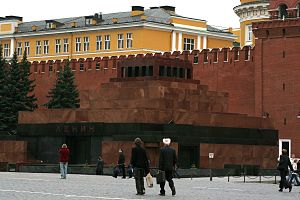
It was in Petrograd that in 1917-19 the first example of the new style was erected on the Field of Mars consisting of a monument designed by Lev Rudnev (1886-1956) Strugglers of the Revolution. This complex consisted of a series of laconic and expressive granite monoliths, and became the focal point of further development in Soviet sculptural and memorial architecture.
However the most famous construction of this time was indeed Lenin's Mausoleum by Alexey Shchusev. Originally a temporary wooden structure stood, topped with a pyramid, with two attachments for entrance and departure. In 1930 it was replaced with the present building set in stone. The combination of dark red and black labradorite punctuated the slenderness and precision of the construction.
The massive development of technological processes and materials also influenced on the constuctivist elements in structure design. During the erection of the Volkhov Hydroelectric Station (1918-26, architects O.Munts and V.Pokrovsky), the traditional outlines on the window arches is still used (despite concrete being employed in construction). However the Dnieper Hydroelectric Station (1927-32) which was built by the collective of architects headed by Viktor Vesnin (1882-1950) took an innovative decision that had a curved dam with a rhythmic pattern of foundations. A large role in the architectural life of 1920s Russia was played by creative unions, one of which that was formed in 1923, was the Association of New Architects (Asnova), which put forward an idea of synthesisng architecture and other creative arts in the way that building gained an almost sculptural external impression, these were to serve as visual points for orientation of a human in space. Members of Asnova also developed the first designs of Moscow's skyscrapers, none of which were realised at the time (1923-1926).
Another new creation that came from post-revolutionary Russia was a new type of public buildings such as Worker's club or Palace of Culture. These became a new focus for architects, who used the visual expression of large elements blended with industrial motifs. The most famous of these was the Zuev Club (1927-29) in Moscow by Ilya Golosov (1883-1945), whose composition relied on the dynamical contrast of simple shapes, planes, complete walls and glazed surfaces.
The symbolical expression of construction became the showpiece in works designed by Konstantin Melnikov (1890-1974), notably Rusakov Workers' Club (1927-1929) in Moscow. Visually the building resembles resembles a part of a gear and each of the three cantilevered concrete "teeth" is a balcony of the main auditorium that could be used individually or combined into a large theater hall. The sharpness of the volumetric composition and the "transition" of internal space (often called by Melnikov himself as a "tensed muscle" made it one of the most important structures of Soviet Architecture.
Post-war Soviet Union
Main article: Stalinist Architecture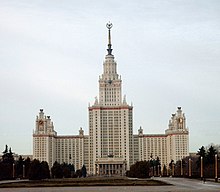
Stalinist architecture put a premium on conservative monumentalism. In the 1930's, there was rapid urbanisation as a result of Stalin's policies. There was an international competition to build the Palace of the Soviets in Moscow in that decade.
After 1945, the focus was on rebuilding the buildings destroyed in World War II but also erecting new ones: seven high-rise buildings were built at symbolic points in Moscow's space. The building of Moscow University (1948-1953) by Lev Rudnev and associates is particularly notable for its use of space. Another notable example is the Exhibition Centre in Moscow which was built for the second All-Union Agricultural Exhibition (VSKhV) in 1954, that featured a series of pavilions each decorated in the style of the feature that they represent. The other famous examples are the stations of the Moscow Metro and Saint Petersburg Metro's that were built during the 1940s and 1950s are world famous for their extravagant designs and vivid decorations. In general the Stalinist architecture completely changed the way many post-war cities look, and mostly survive to this day in central avenues and public buildings.
However after the death of Stalin in 1953, the social and political changes literally turned the country over. The construction priorities were too affected and as were the architecture. In 1955, Nikita Khrushchev faced with the problem of the slow paced construction of housing, called for drastic measures to accelerate the process, and this involved developing new more mass-productive technologies and removing "decorative extras" from the buildings.

Effectively this put an end to the Stalinist Architecture, however as the transition was slow, most of the existing projects, that were in plan or even started to be built by 1955 were directly affected, the result was at times complete squares becoming unsymmetric.
The most famous of which took place in the post-war reconstruction of the Ukrainian capital Kiev where the planned Kreschatik avenue along with its central square Ploschad Kalinina were to form a single rich space enclosed by Stalinist constructions. However, as the buildings enclosing the latter were in process of completion, under direct orders, the architects were forced to alter them, and as a result the whole ensemble was left unfinished until only the early 1980s. In particular was Hotel Ukrayina, that was to crown the square which was originally to look similar to one of Moscow's "Seven sisters", was left as a solid shape without the top spire or any of the rich external decoration.
Nevertheless, as the buildings became more square and simple, they brought with them a new style fueled by the Space Age- functionality. The State Kremlin Palace is a merit to an earlier attempt to make a bridge between the rapidly changing styles as dictated by the state. The Ostankino Tower is more of symbolism of technological advances and future.

In terms of simpler buildings, then 1960s are mostly remembered for their massive housing plans. A new typical project was developed using nothing but concrete panels to make a simple 5-story house. These Pyatietazhki became the most dominant housing constructions. Although rapidelly built, the quality was in nothing compared to earlier housing and their almost identical look contributed to the grey and dull stereotype of socialist cities.
As the 1970s opened, Leonid Brezhnev allowed more choice to the architects, soon housing of varying calibers were opened. Slowly the flat blocks gained height in floors and in external decoration, large mosaics on their side became a feature. In almost all cases these were built not as standalone constructions, but part of a large estate (housing massif) that soon became a central feature of Socialist cities. Public buildings were built with varying themes. Some, like the White House of Russia made direct connections with earlier 1950s architecture, with white marble faced exterior and large bas-reliefs on the wings.

Modern Russia
As the Soviet Union fell apart many of its projects were put on hold, and some cancelled altogether. However for the first time, there was no longer any control over what theme or how high a building should be. As a result, and with generally improving financial conditions, architecture blossomed in unbelieving rates. For the first time modern methods of skyscraper buildings were implemented and resulted in an ambitious business centre being built in Moscow Moscow-City. In other cases architects returned to the most successful designs, particularly Stalinist architecture which resulted in buildings like Triumph Palace in Moscow.
See also
- Tented roof
- Stalinist architecture
- Constructivist architecture
- Palace of Soviets
- Latvian Academy of Sciences
- Alexander Nevsky Cathedral, Warsaw
- Warsaw Palace of Culture and Science
References
- "Architecture: Kievan Rus and Russia" in Encyclopædia Britannica (Macropedia) vol. 13, 15th ed., 2003, p. 921.
- William Craft Brumfield, Landmarks of Russian Architecture: A Photographic Survey. Amsterdam: Gordon and Breach, 1997
- John Fleming, Hugh Honour, Nikolaus Pevsner. "Russian Architecture" in The Penguin Dictionary of Architecture and Landscape Architecture, 5th ed., 1998, pp. 493–498, London: Penguin. ISBN 0-670-88017-5.
- Russian art and architecture, in The Columbia Encyclopedia, Sixth Edition, 2001–05.
- Encyclopædia BritannicaWestern architecture retrieved 12 August 2005
- About.com feature on Russian architecture retrieved 12 August 2005
- Grove Art Online articles on Russian architecture Oxford University Press 2005 retrieved 12 August
- Russian Life July/August 2000 Volume 43 Issue 4 "Faithful Reproduction" an interview with Russian architecture expert William Brumfield on the rebuilding of Christ the Saviour Cathedral
Further reading
- William Craft Brumfield, A History of Russian Architecture. Seattle and London: University of Washington Press, 2004. ISBN 0-295-98393-0
External links
- Template:Ru icon Russian photosite of Orthodox architecture
- Template:Ru icon Russian society of arhitects
- Template:En icon The William C. Brumfield Collection, part of Meeting of Frontiers: Siberia, Alaska, and the American West
- Template:Uk icon "Architectural links between Ukraine and Russia" by Igor Grabar
| Architecture of Europe | |
|---|---|
| Sovereign states |
|
| States with limited recognition | |
| Dependencies and other entities | |